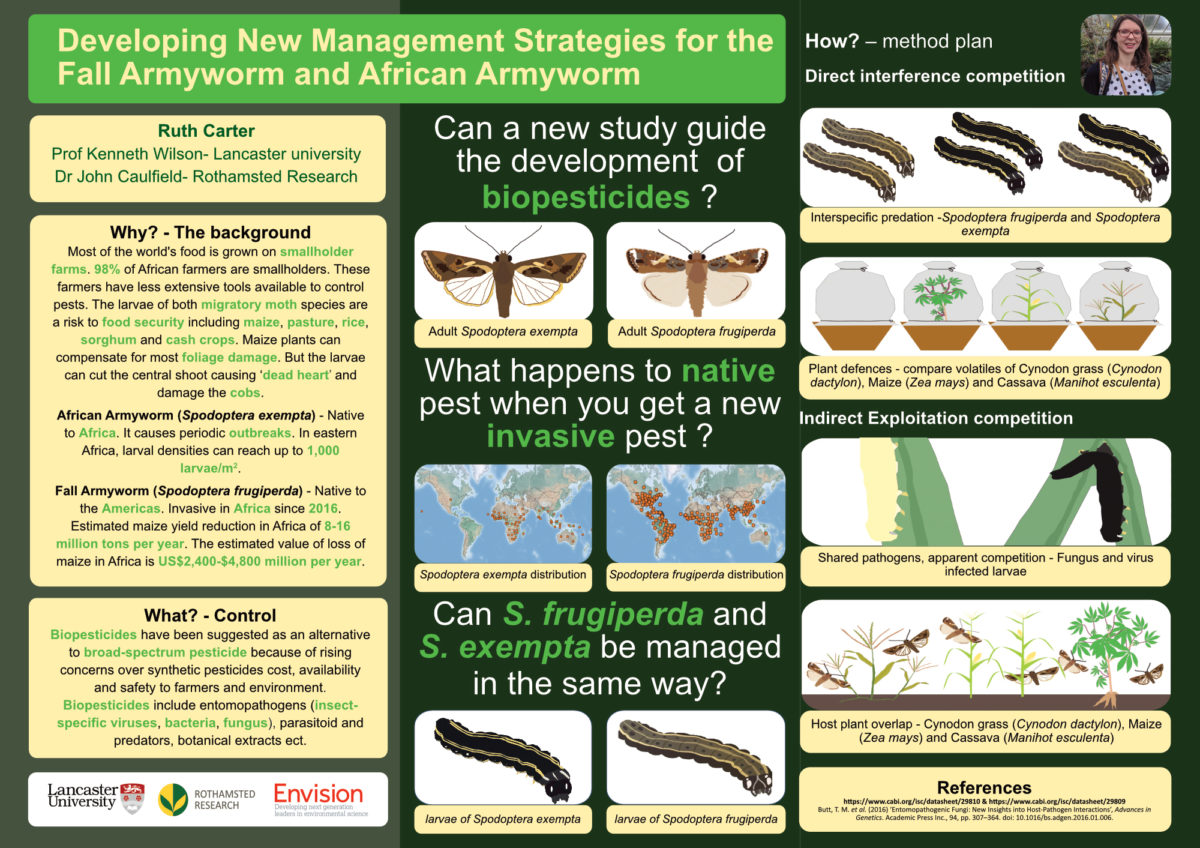Summary
Both the Fall Armyworm moth (Spodoptera frugiperda), the African Armyworm moth (Spodoptera exempta) are a significant threat to African food security. Since S. frugiperda arrival in Africa four years ago, it has already spread throughout sub-Saharan Africa. Also, with the rise of pesticide poisoning in Africa, it is essential to find alternatives. I aim to study direct and indirect competition, including interspecific predation, shared natural enemies, shared host plants, and induced plant defences.
The target audience for my poster is specialists in my field of study.
Transcript
Background
Most of the world’s food is grown on smallholder farms. 98% of African farmers are smallholders. These farmers have less extensive tools available to control pests. Both African Armyworm (Spodoptera exempta) and Fall Armyworm (Spodoptera frugiperda) larvae feed on staple food crops such as maize and pastureland such as Cynodon grass. Both moth’s larvae can reduce yields, directly damage cobs and cut the central stem causing ‘dead heart’ requiring maize plants to be replanted. Larval outbreaks of S. frugiperda and S. exempta can resemble a marching army. S. exempta larval densities can reach up to 1,000 larvae/m2. My PhD will focus on maize and pastureland, including Cynodon grass.
S. exempta is native to Africa. It causes periodic outbreaks which can cause complete loss of the crop. The primary outbreak of S. exempta are in Tanzania and Kenya before it spreads across Africa. Unlike the S. exempta, S. frugiperda only arrived in Africa four years ago and is now spread across sub-Saharan Africa into Asia and more recently into Australia. The estimated value of loss of maize to fall armyworm in Africa is US$2,400-$4,800 million per year.
Control
Biopesticides have been suggested as an alternative to broad-spectrum pesticide because of rising concerns over synthetic pesticides cost, availability and safety to farmers and the environment. Biopesticides include entomopathogens (insect-specific viruses, bacteria, fungus), parasitoid and predators, botanical extracts ect.
Aims of my PhD
My PhD aims to answer these questions: Can a new study guide the development of biopesticides? What happens to native pest when you get a new invasive pest? Can S. frugiperda and S. exempta be managed in the same way?
Method
I will look at the direct competition including interspecific predation compare behaviour of S. frugiperda and S. exempta together to control. I will study plant defences by comparing volatiles of Cynodon grass (Cynodon dactylon), Maize (Zea mays) with and without larvae damage. I will investigate Indirect Exploitation competition by studying if both larvae can be controlled by the same strain of virus and fungus or if different strains are needed. I will also study if there is host plant overlap between the two moths.
References
Including original content, figures made by Ruth Carter
https://www.cabi.org/isc/datasheet/29810 & https://www.cabi.org/isc/datasheet/29809
Butt, T. M. et al. (2016) ‘Entomopathogenic Fungi: New Insights into Host-Pathogen Interactions’, Advances in Genetics. Academic Press Inc., 94, pp. 307–364. doi: 10.1016/bs.adgen.2016.01.006.
Rose, D. J. W., Dewhurst, C. F. and Page, W. W. (2000) The African Armyworm Handbook The Status, Biology, Ecology, Epidemiology and Management of Spodoptera exempta (Lepidoptera: Noctuidae) Second Edition.
Ruth Carter

Ruth’s lifelong passion for insects has inspired her to take part in various work experiences. She completed her undergraduate degree in Biology at Royal Holloway University and her Master’s degree in Entomology at Harper Adams University. Ruth worked as a Research Assistant at The Pirbright Institute, with a team researching the Diamond Back Moth. Throughout her PhD at Lancaster University with Rothamsted Research, Ruth will investigate if the Fall Armyworm moth competes with the African armyworm moth.
Email: r.carter6@lancaster.ac.uk
Twitter: @Ruthentomology
Organisation: Lancaster University and Rothamsted Research

